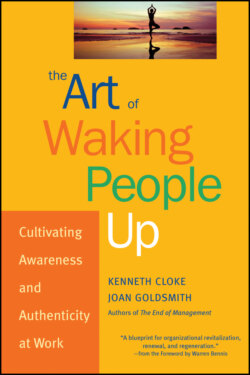Читать книгу The Art of Waking People Up - Kenneth Cloke - Страница 28
1
An Orientation to Awareness and Authenticity
ОглавлениеI consider many adults (including myself) are or have been, more or less, in a hypnotic trance, induced in early infancy: we remain in this state until—when we dead awaken . . . we shall find that we have never lived.
R. D. Laing
We have all encountered employees who seem barely awake, who squander their work lives, who blind themselves to what is taking place within and around them, who speak and act inauthentically, who do not care about what they do, how they do it, to whom, or why. Indeed, many of our workplaces seem populated with the living dead, zombies who wrap themselves in a hypnotic trance, as psychiatrist R. D. Laing described, only to find that they have numbed themselves so thoroughly that they are unable to really live.
This indolent, apathetic, somnolent state has countless faces. It can be found in preoccupations with the past and unrealistic expectations for the future; in attitudes of denial, defensiveness, and disregard for the present; in frustration over failed change efforts; in reduced enthusiasm due to hierarchical privilege, bureaucratic indifference, and autocratic contempt; in a variety of mesmerizing relationships, processes, cultures, systems, structures, and attitudes that limit the capacity to perceive and act based not only on what is taking place within and around us and diminish who we are as human beings.
This zombification and atrophication of work life happens incrementally whenever people are punished for being aware and authentic and, as a result, become frustrated, give up, cease caring, and stop trying. It occurs when managers stop telling the truth and lie or keep silent about things that matter. It occurs when feedback is no longer oriented to how employees can succeed but to how they have failed—not just in their work but as human beings. It occurs when performance assessments become judgmental and hierarchical rather than supportive and participatory; when organizations separate honesty from kindness, integrity from advancement, and respect from communication.
Numbing oneself to experience is a natural response to unfulfilled expectations, unprocessed pain, unfinished grieving, unresolved conflict, and repetitive disappointment. When employees experience repeated losses, pain, conflicts, and disappointments, they often withdraw, shut down, or defend themselves from bruised feelings and unhappy thoughts. In doing so, they deaden themselves to experience and to the pain they would otherwise feel if they were fully awake. The extreme forms of this emotional state are catatonia and schizophrenia, but more familiar examples include apathy, distracted behavior, superficiality, equivocation, isolation, substance abuse, recurring illness, stress-related injuries, cynicism, excessive absenteeism, hypersensitivity, and unresolved conflicts.
When employees defend themselves against awareness and authenticity even in small ways, they diminish their capacity for growth, cease being fully alive and slip into a kind of unfulfilling stupor. How, in this state, is it possible for them to learn or change? What could conceivably motivate them to continue developing, sharpening, and expanding their skills? How do they ever overcome their tragedies or learn to celebrate their triumphs? How do they become responsible team members, improve the quality of their work, or risk changing what is not working?
In truth, their only real option in the face of these disabling experiences is to wake up and change their attitude toward what they have experienced. As they wake up, they increase their awareness, become more authentic, discover where their organization is not congruent with its professed values, and commit to improve their work processes, organizations, relationships, communities, and environments—not once or in isolation, but continually and collaboratively with others. This is how they actually transform their work lives.
As people wake up, they become increasingly conscious of the dysfunctional elements in their work environments and relationships and can see what is not working or might work better. They can then abandon the destructive patterns, adversarial attitudes, injured feelings, upsetting memories, and addictive behaviors that keep them mired in the past. They can release unrealistic expectations for the future and attitudes of defensiveness and denial regarding the past. They can take responsibility for what they do and who they are, for their behaviors and the results they produce. They can then assume the arduous task of transforming their personal, organizational, social, political, and economic lives and creating more satisfying, sustainable, and supportive work environments.
